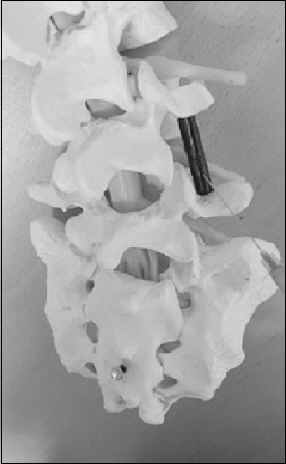Anesth Pain Med.
2016 Jul;11(3):291-294. 10.17085/apm.2016.11.3.219.
Ultrasound-guided pararadicular block using a paramedian sagittal oblique approach for managing low back pain in a pregnant woman: A case report
- Affiliations
-
- 1Department of Anesthesiology and Pain Medicine, Seoul St. Mary's Hospital, College of Medicine, The Catholic University of Korea, Seoul, Korea. anekyh@catholic.ac.kr
- KMID: 2344934
- DOI: http://doi.org/10.17085/apm.2016.11.3.219
Abstract
- Lumbar radicular pain is conventionally treated with transforaminal epidural injection under the guidance of fluoroscopy or computer tomography. However, fluoroscopic radiation can be hazardous in certain populations, including pregnant women. An adjustment of the amount of local anesthetic is required in this population. An alternative method of lumbar root block using ultrasound (US) guidance has recently been introduced. Here, we present the case of a pregnant woman with worsening lumbar radicular pain during her pregnancy and the management of her pain using US-guided pararadicular block.
Keyword
MeSH Terms
Figure
Reference
-
1. Han IH. Pregnancy and spinal problems. Curr Opin Obstet Gynecol. 2010; 22:477–81. DOI: 10.1097/GCO.0b013e3283404ea1. PMID: 20930629.2. Kim YH, Park HJ, Moon DE. Ultrasound-guided pararadicular injection in the lumbar spine: a comparative study of the paramedian sagittal and paramedian sagittal oblique approaches. Pain Pract. 2015; 15:693–700. DOI: 10.1111/papr.12249. PMID: 25313534.
Article3. Loizides A, Gruber H, Peer S, Galiano K, Bale R, Obernauer J. Ultrasound guided versus CT-controlled pararadicular injections in the lumbar spine: a prospective randomized clinical trial. AJNR Am J Neuroradiol. 2013; 34:466–70. DOI: 10.3174/ajnr.A3206. PMID: 22821925.
Article4. Scharwächter C, Röser A, Schwartz CA, Haage P. Prenatal radiation exposure: dose calculation. Rofo. 2015; 187:338–46. DOI: 10.1055/s-0034-1398817. PMID: 25750112.
Article5. Gupta R, Singh S, Kaur S, Singh K, Aujla K. Correlation between epidurographic contrast flow patterns and clinical effectiveness in chronic lumbar discogenic radicular pain treated with epidural steroid injections via different approaches. Korean J Pain. 2014; 27:353–9. DOI: 10.3344/kjp.2014.27.4.353. PMID: 25317285. PMCID: PMC4196501.
Article6. Gofeld M, Montgomery KA. Spine ultrasonography: interventions and diagnostics. Pain Manag. 2012; 2:373–82. DOI: 10.2217/pmt.12.27. PMID: 24654723.
Article7. Kim YH. Ultrasound-guided interventions for spinal pain. Anesth Pain Med. 2012; 7:271–9.8. Barash PG, Cullen BF, Stoelting RK, Cahalan MK, Stock M, Christine OR. Clinical Anesthesia. 7th ed. Philadelphia: Lippincott Williams & Wilkins;2013. p. 562–77.9. Visser WA, Lee RA, Gielen MJ. Factors affecting the distribution of neural blockade by local anesthetics in epidural anesthesia and a comparison of lumbar versus thoracic epidural anesthesia. Anesth Analg. 2008; 107:708–21. DOI: 10.1213/ane.0b013e31817e7065. PMID: 18633056.
Article10. Scanlon JW, Brown WU Jr, Weiss JB, Alper MH. Neurobehavioral responses of newborn infants after maternal epidural anesthesia. Anesthesiology. 1974; 40:121–8. DOI: 10.1097/00000542-197402000-00005. PMID: 4812709.
Article11. Zeisler JA, Gaarder TD, De Mesquita SA. Lidocaine excretion in breast milk. Drug Intell Clin Pharm. 1986; 20:691–3. DOI: 10.1177/106002808602000913.
Article12. Bajwa SJ, Bajwa SK. Anaesthetic challenges and management during pregnancy: Strategies revisited. Anesth Essays Res. 2013; 7:160–7. DOI: 10.4103/0259-1162.118945. PMID: 25885826. PMCID: PMC4173524.
Article
- Full Text Links
- Actions
-
Cited
- CITED
-
- Close
- Share
- Similar articles
-
- Erector Spinae Plane Block in Patients with Low Back Pain
- Continuous Femoral Nerve Block Guided by Ultrasound Sonography in Metastatic Cancer Patient: A case report
- Treatment of Isolated Sternal Fracture with Ultrasound-Guided Paravertebral Nerve Block: a Case Report and Literature Review
- Ultrasound-Guided Lumbar Transforaminal Epidural Injection: A Narrative Review
- Ultrasound Guided Therapeutic Medial Branch Block for the Facet Joint Pain



